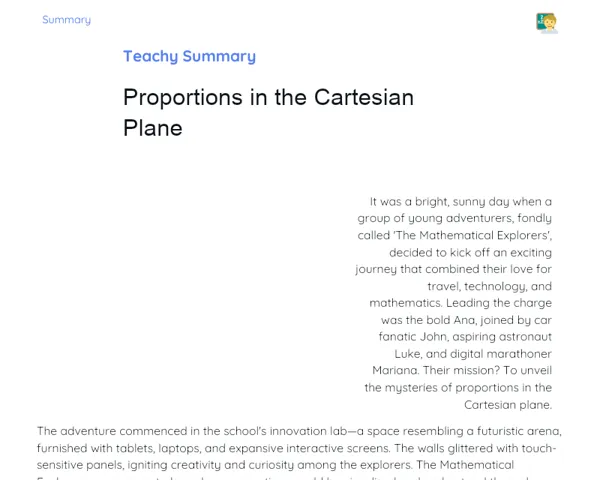Socioemotional Summary Conclusion
Goals
1. Understand the concept of reflection symmetry and its application in geometric figures.
2. Develop the ability to identify and draw reflected figures, especially triangles.
3. Connect mathematical learning to socio-emotional skills, such as self-awareness and responsible decision-making.
Contextualization
Have you ever noticed how a butterfly's wings are perfectly alike? Or why many beautiful buildings give off this sense of balance and harmony? All of this is thanks to the concept of reflection symmetry! 🌿 Artists, architects, and even nature employ this principle to craft beauty and proportion. Let’s delve into how mathematics elucidates these captivating phenomena and simultaneously nurture skills that transcend mere numbers and calculations!
Exercising Your Knowledge
Definition of Reflection Symmetry
Reflection symmetry is a geometric property where a shape can be split into two identical parts mirrored across an axis. Just like when you gaze into a mirror, everything on the left appears on the right, and vice versa. This fascinating aspect of reflection creates harmony and balance in geometric figures.
-
Axis of Symmetry: This is the line that divides the shape into two mirrored halves. It can be horizontal, vertical, or diagonal.
-
Identical Parts: The two halves of the shape are exactly the same, albeit inverted.
-
Preservation of Properties: The reflected shape retains its measurements and proportions, but its orientation is flipped.
Application in Plane Figures
We can apply reflection symmetry to various flat shapes like triangles, squares, and circles. This practice enriches our understanding of geometry while enhancing our spatial awareness. Observing reflected figures helps us perceive the world through a fresh lens, emphasizing symmetry and balance.
-
Triangles: Reflecting a triangle across an axis produces an image that perfectly mirrors the original.
-
Squares and Rectangles: These are straightforward to visualize since they possess multiple axes of symmetry.
-
Circles: While a circle might appear symmetrical in all directions, reflecting half of it across an axis still showcases radial symmetry.
Properties of Reflections
When a figure is reflected, the resulting image maintains the same dimensions and shapes, but its orientation is flipped. This property is essential for solving geometric problems and forms the foundation for various advanced concepts in mathematics and art.
-
Orientation Inversion: The reflected figure becomes an inverted image (left/right, top/bottom) of the original.
-
Measurement Conservation: All measurements, including sides and angles, remain unchanged.
-
Applicability: This property finds its use in design, architecture, and many other domains to create visual symmetries.
Key Terms
-
Reflection Symmetry: A geometric property where a figure is divided into identical mirrored parts.
-
Axis of Symmetry: A line that divides the figure into two mirrored halves.
-
Reflected Figure: An inverse image of the original figure concerning the axis of symmetry.
For Reflection
-
How do you feel while working with symmetrical figures? Does it offer you a sense of harmony and balance?
-
What emotional hurdles have you faced while drawing reflected figures? How did you manage those feelings?
-
Think of a scenario outside school where symmetry is significant. How can grasping reflection symmetry enhance your appreciation or help in tackling challenges in that situation?
Important Conclusions
-
Reflection symmetry is a captivating geometric property where a figure can be split into two identical mirrored halves.
-
We have learned how to identify and draw reflected figures, particularly triangles, across a specified axis.
-
Linking these mathematical concepts to socio-emotional skills is crucial for cultivating abilities like self-awareness and responsible decision-making.
Impacts on Society
Reflection symmetry significantly influences various aspects of our daily lives. In architecture, for instance, it contributes to the creation of aesthetically pleasing and balanced buildings. We can also observe this same symmetry in renowned artworks and the natural world, such as in butterfly wings and leaf structures, which brings beauty and cohesion to our environment. 📐🏛️ Furthermore, a solid understanding of reflection symmetry equips us with vital skills like problem-solving and critical thinking. This not only enhances our academic performance but also better primes us to face real-life issues. Mastering and applying symmetry can foster an analytical and creative mindset, which is indispensable for innovation and crafting effective solutions across any field. 🚀🧠
Dealing with Emotions
To practice the RULER method at home, try this exercise: Take a moment of calm in your day to reflect on the emotions you experienced while learning about reflection symmetry. Acknowledge those feelings (like frustration or satisfaction) and analyze what triggered them (perhaps the challenge of drawing the figure or the joy of achieving perfect symmetry). Accurately label those emotions and consider how you expressed them in class. Finally, envision how you can manage those feelings constructively in similar situations in the future, such as seeking assistance from classmates or teachers and maintaining composure when stressed.
Study Tips
-
Regularly practice drawing reflections on graph paper. This will bolster your accuracy and visual grasp of reflection symmetry.
-
Watch online videos and tutorials explaining symmetry in various contexts, such as nature, art, and architecture.
-
Form study groups with your friends to discuss and solve symmetry problems collaboratively. Teamwork can make learning more enjoyable and effective.



